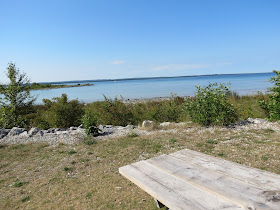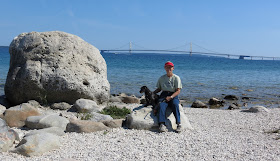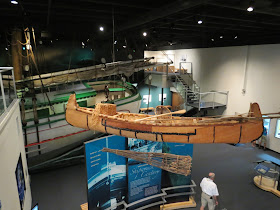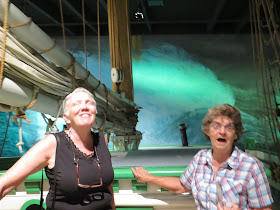From Alpena, we followed the coast of Lake Huron north to Mackinaw City. This view from a rest area along the route.
Mackinaw Mill Creek Campground is not far from the big bridge to the Upper Peninsula.
One evening we all attended a lumberjack show. Our team was cheering for Dakota.
We watched him chop,
Throw,Saw,
Run across floating logs,
And climb a pole. Dakota won the competition.
Sarah thought the announcer was cute.
Another day some of us visited The Headlands, one of only 10 designated International Dark Sky Parks in the world. There are over 600 acres of old-growth forest with trails, and 2 1/2 miles of frontage on Lake Michigan.
The park is free, open 24 hours for dark-sky viewing opportunities. You can bring you sleeping bag, or you can rent this Beach House for your dark-sky viewing experience. It would have been a great night to do it, but we didn't come back at night.We toured the McGulpin Point Lighthouse, constructed in 1868.
Down the hill from the lighthouse is Big Rock, described as far back as 1749 in a letter sent back to France, as being at times high and dry, and at other times completely covered with water. The Straits of Mackinaw rises and falls as much as 8 feet over periods of time.
Carol and Maggie on the trail back up to the lighthouse.
I climbed the circular stairs to the top.
You have to crawl through this little door to get out on the viewing platform.
Later we stopped for a photo op at the Old Mackinac Point Lighthouse (1889) by the bridge.
We drove by the Coast Guard Ice Crusher, but did not tour it.
We decided we had to try a famous pastie.
Inside we dubiously look over the pastie options.Pasties originated as a hand-held meal for miners. Wives would bake meat and vegetables in a crust and wrap it in layers of linen and newspapers for their husband's lunch.
My vegetable and cheese Pastie Italiano was not exactly "hand-held" material.
And a staple vegetable in all of them was rutabaga, not one of my favorites.
Some chose the beef or chicken options.
We all survived our Pastie experience, although I don't think any of us want to do it again.
Our next destination was Sault Ste Marie, home of the Soo Locks, seen here in aerial view. On the far left is the Visitor Center and viewing platforms, from which we watched big ships go through the closest two locks.
Viewing platforms.
A big freighter approaches from lower Lake Huron.
You can see how much higher Lake Superior is at the other end of the lock.It is a tight fit.
Workers carry the lines in preparation for tying them off once the ship is completely inside the lock.
A view of the cargo holds. An announcer describes the ship....this one is Canadian, and its cargo, I think iron.
Lines are fastened and the lock gates are closing.
Water begins to fill the lock. The bridge to Canada can be seen in the background.
Water is rising quickly.
The viewing platforms were wet from last night's rains.
This pigeon was catching a ride through the lock.
The locks open into Lake Superior.
A worker waits for the signal to release the lines.A winch will pull the line back aboard the ship.
We had a lunch of fresh Lake Superior Whitefish at a local restaurant and then returned to watch another ship go through the locks the other way. Both ships were over 1000 feet in length.
This sculpture in the Courthouse square. It depicts a Sand Hill Crane with Indian children.
The Indian Legend...remember we had just eaten Whitefish for lunch.
County Courthouse
Our next stop was the little town of Grand Marais where we camped for a week on the shores of Gitche Gumee, as the Chippewa Indians called the "big water."
THis little rock guy helps you find the trail back to the stairs.The shoreline is strewn with pretty pebbles. You can find agates if you know what you're looking for.
The campground sits high on a bluff with benches to watch the water and sunset.
We decided to stay here through the Labor Day weekend and explore the area.






























































































